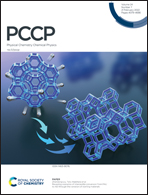Molecular dynamics study of Cr doping on the crystal structure and surficial/interfacial properties of 2H-MoS2†
Abstract
Molecular doping has proved to be an efficient technique to improve the properties of pristine materials. A better understanding of it is quite necessary. For the first time, the force field parameters of the transition metal chromium (Cr) doped in 2H-MoS2 in molecular dynamics (MD) were developed. Compared with the DFT calculation results, the error in the stable-state lattice parameters is less than 1%. The optimized force field parameters were used for the MD simulation of different amounts of Cr substitution doping in 2H-MoS2. This study found that the Cr doping at different sites will have a significant impact on the stability of the bulk 2H-MoS2. With increasing doping amount, the water contact angle increases from 69.2° ± 2° to 78.5° ± 0.4°, and the hydrophobic performance is obviously improved. Finally, we also found that the adsorption energy of Cr-MoS2 decreased with increasing Cr doping content, indicating that bulk MoS2 is easier to separate to form single- or fewer-layer 2H-MoS2 in the case of higher doping content. Comparison between the simulated adsorption energies of typical solvents on the 2H-MoS2 surface shows that methanol (CH3OH) and water (H2O) can separate bulk 2H-MoS2, which matched with the experimental results. By using high-precision force field parameters, molecular dynamics were performed to study the surface/interface characteristics of Cr-doped 2H-MoS2, and provided an effective and detailed description for future experimental design.



 Please wait while we load your content...
Please wait while we load your content...